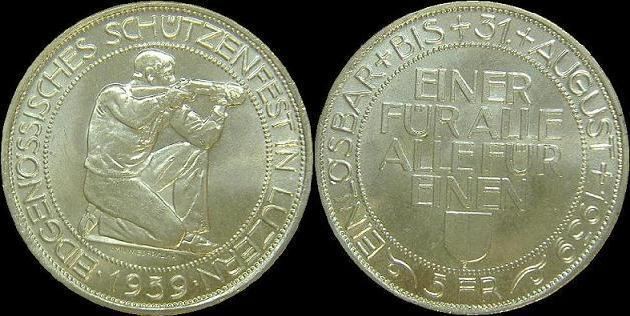 | ||
A shooting thaler (/ˈʃuːtɪŋ tɑːlərz/ TAH-lərz; German: Schützentaler, French: Écu de tir) is a commemorative coin minted to commemorate one of the Schützenfest (French: Fête de tir) or free shooting (German: Freischiessen, French: Tir libre) tournaments held in various cantons within the Swiss Confederation. Most of the designs differ from their circulating counterparts, though the pieces issued for the shooting festivals in Geneva in 1851 and Solothurn in 1855 are exceptions. Most shooting thaler designs depict strongly cantonal or patriotic themes, such as historical military leaders or heraldry. The entire series can be distinguished from shooting medals by their adherence to the specifications of circulating coinage. All but the Stans and St. Gallen issues are denominated. Other countries have minted coins in honor of shooting festivals or marksmanship competitions, but only Swiss pieces are considered shooting thalers.
Contents
- History
- Chur
- Glarus
- Geneva
- Solothurn
- Bern
- Zrich
- Stans
- La Chaux de Fonds
- Schaffhausen
- Schwyz
- Zug
- St Gallen
- Lausanne
- Basel
- Fribourg
- Lugano
- Etymology
- Shooting medals
- Other countries
- References
The first shooting thaler was issued for the Chur shooting festival in 1842 and is denominated at four francs. The second, issued for Glarus, has a face value of forty batzen. The third, minted for the shooting festival in Geneva, is denominated at ten francs. A total of eighteen designs were struck in the nineteenth century, concluding with the Bern issue of 1885. All those struck from 1855 to 1885 bear the denomination of five francs. Many nineteenth-century issues were also struck in various other metals besides silver, including gold and white metal, in small quantities. In 1934, a new series began production. This series, however, was cut short due to the outbreak of World War II. Another series of shooting thalers began mintage in 1984. The first coins issued in this new series were those minted for the festival at Oberhasli. Every year since has seen the mintage of two coins, each bearing the same design, one struck in silver, the other in gold. The only exceptions are the issues of Zürich and Sion in 1999, one of which was struck in copper–nickel, two in silver and two in gold. Until 1995, silver issues were denominated at fifty francs, while gold pieces were denominated at 1,000 francs. Later, gold issues were denominated at 500 francs, excepting only the Zürich issues of 1999.
History
The first shooting thalers were cantonal pieces, minted by the sovereign cantons of Switzerland. All of these pieces, as well as the 1855 Solothurn issue, were strictly legal tender. Nineteenth-century Confederation shooting thaler issues were minted to legal fineness, and were thus allowed to bear the denomination of five francs. Beginning in 1865, Switzerland became a member of the Latin Monetary Union. Shooting thalers were not included in the mintages authorized by the Union. Therefore, these issues are commonly considered semi-medallic, though they could circulate due to their size and weight being the same as that of the regular five franc issues. This series of shooting thalers, following the standards of the Latin Monetary Union, began in 1855 with the Solothurn issue and ended in 1885 with the Bern issue. In 1927, the Monetary Union ceased to exist. Mintage began on a new series of shooting thalers in 1934 in honor of the shooting festival in Fribourg, and another design was issued in 1939 for the Lucerne festival. The 1934 issue was the last official shooting thaler that matched the circulating counterpart in both diameter and weight. The 1939 issues were not the same size and weight as their circulating counterparts, but both issues were redeemable only at the shooting festival or participating businesses. Production of shooting thalers was cut short with the outbreak of World War II. In 1984, a new series of shooting thalers began mintage, due largely to the efforts of California-based coin dealer Richard Nelson. These issues, like those minted in 1934 and 1939, are not minted to legal fineness and are not considered legal tender.
Chur
Glarus
Geneva
Solothurn
Bern
Zürich
Stans
La Chaux-de-Fonds
Schaffhausen
Schwyz
Zug
Zürich
St. Gallen
Lausanne
Basel
Fribourg
Lugano
Bern
Etymology
Though no coins denominated as thalers were officially issued within the Swiss Confederation, many coins measuring between 30 and 40 millimeters have been given the name unofficially due to the similarity in size to German and Austrian thalers.
Shooting medals
The first shooting medals were struck in honor of the Officers' Shoot held in Langenthal, Bern, in 1822. They can usually be distinguished from shooting thalers by their lack of denomination and difference in weight and often composition, though there is evidence that many of thaler-size did circulate amongst the legal tender coins of Switzerland. Shooting medals were minted in a variety of metals, including silver, bronze, goldene and white metal.
Other countries
Though not considered shooting thalers, some other European coin-issuing entities have minted coins to honor or promote shooting festivals that took place within their territory. Examples include the German States of Baden, Bremen, Frankfurt am Main and Hanover, as well as the Swiss canton of Vaud.
